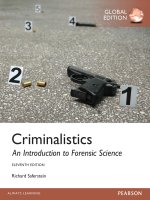Lecture An introduction to computer science using java (2nd Edition): Chapter 12 - S.N. Kamin, D. Mickunas, E. Reingold
Bạn đang xem bản rút gọn của tài liệu. Xem và tải ngay bản đầy đủ của tài liệu tại đây (368.2 KB, 39 trang )
Chapter 12
Inheritance and Exceptions
Lecture Slides to Accompany
An Introduction to Computer
Science Using Java (2nd Edition)
by
S.N. Kamin, D. Mickunas, E. Reingold
Chapter Preview
In this chapter we will:
• show how to organize predefined classes using Java
packages
• how access to methods and variables is controlled
• discuss the use of class inheritance to refine and
extend classes
• refine our presentation on Java interfaces as a means
of specifying object behavior
• show how programmer-defined exceptions are
created, thrown and caught
Java Packages
• Application programmer interface (API)
– All classes provided to programmers along with
the Java compiler (e.g. Math or MouseEvent)
– Java expects to find these classes in separate
directories or folders
• The classes stored in each directory form a
package
• The package names are formed by
concatenating the directory names starting
from a particular root directory
Some Predefined Java Packages
Package Name
Contents
java.applet
Classes for implementing applets
java.awt
Classes for graphics, windows, and GUI’s
java.awt.event
Classes supporting AWT event handling
java.awt.image
Classes for image handling
java.awt.peer
Interface definitions s for platform
independent graphical user interfaces (GUI’s)
java.io
Classes for input and output
java.lang
Basic language classes like Math
(always available in any Java program)
java.net
Classes for networking
java.util
Useful
auxiliary classes like Date
Package Component Names
• Using a fully qualified component name
x = java.lang.Math.sqrt(3);
• Using an import statement
// to allow unqualified references to
// all package classes
import package.name.*;
// to allow unqualified references to
// a particular package class
import package.name.class_name;
Import Examples
•
This code
java.util.Date d =
new java.util.Date();
java.awt.Point p =
new java.awt.Point(1,2);
java.awt.Button b =
new java.awt.Button();
•
Can be abbreviated
import java.util.date;
Import java.awt.*;
…
Date d = new Date();
Point p = new Point(1,2);
Button b = new Button();
Creating Your Own Packages
• Each package class must be stored in a file in an
appropriately named directory
• The source code file for each package class must
contain a package statement as its first noncommented statement
package package_name;
• Several packages can be stored in the same
directory
• Classes in different directories cannot be part of the
same package
Visibility Rules and Packages
• Instance variables declared as public or private have
the same visibility to classes in other packages
• Instance variables without explicitly declared visibility
have package visibility
• Instance variables with package visibility are only
visible to methods defined in classes belonging to the
same package
• Similarly for static variables, instance methods, and
static methods having package visibility
• Classes not explicitly declared public are not visible
outside the package
Inheritance
• Allows programmers to customize a class for
a specific purpose, without actually modifying
the original class (the superclass)
• The derived class (subclass) is allowed to
add methods or redefine them
• The subclass can add variables, but cannot
redefine them
Inheritance Example
• Class C is a subclass of class B (its
superclass) if its declaration has the form
class C extends B {
…
}
• The subclass is a specialization of the
superclass
• The superclass is a generalization of the
subclass
Inheritance and Messages
• When C is a subclass of B
– C objects can respond to all messages that B
objects can respond to
– In general C objects can be used whenever B
objects can be used
• It is possible the a subclass of B may have
methods and variables that have not been
defined in B
– It is the case B objects may not always be used in
place of C objects
Inheritance Hierarchy
• A class may have several subclasses and
each subclass may have subclasses of its own
• The collection of all subclasses descended
from a common ancestor is called an
inheritance hierarchy
• The classes that appear below a given class in
the inheritance hierarchy are its descendaents
• The classes that appear above a given class
in the inheritance hierarchy are its ancestors
Inheritance and Visibility Rules
• Private variables and methods are not visible
to subclasses or clients
• Public variables and methods are visible to all
subclasses and clients
• Variables and methods with package visibility
are only visible to subclasses and clients
defined in the same package as the class
• A variable or method declared with the
protected visibility modifier can only be
referenced by subclasses of the class and no
other classes
Visibility and Inheritance
Visibility
Public
default
protected
private
Clients in same
package
C
C
C
None
Clients in different
packages
C
None
None
None
Subclass in same
package
C&R
C&R
C&R
None
Subclass in
different package
C&R
None
R
None
Note: R is receiver; C is client
Overriding vs Overloading
• A method is overloaded if it has multiple
definitions that are distinguished from
one another by having different
numbers or types of arguments
• A method is overridden when a
subclass gives a different definition of
the method with the same number and
types of arguments
Constructors
• The general rule is that when a subclass is
created Java will call the superclass
constructor first and then call the subclass
constructors in the order determined by the
inheritance hierarchy
• If a superclass does not have a default
constructor with no arguments, the subclass
must explicitly call the superclass constructor
with the appropriate arguments
Using super( ) Call Constructor
• The call to super must be the first statement
in the subclass constructor
• Example:
class C extends B {
…
public C ( … ) {
super( B’s constructor arguments );
…
}
…
Calling Overridden Superclass
Methods from Subclassess
• The following code generates an infinite loop
because toString( ) is interpreted as this.toString( )
public void toString() {
String result = toString();
return (result + “:” + second);
}
• To make a call toString in the superclass instead
public void toString() {
String result = super.toString();
return (result + “:” + second);
}
Creation of Subclass Instances
• Assuming that PreciseClock is a subclass of the
Clock class, the following is legal
Clock dawn;
dawn = new PreciseClock(3,45,30);
• The instance variable dawn will respond to all
PreciseClock messages
• It is not legal to write this since Clock objects cannot
respond to all PreciseClock messages
PreciseClock dawn;
dawn = new Clock(3,40);
Static and Dynamic Binding
• Static Binding
– Determining which method will be invoked to
respond to a message at compile time
• Dynamic Binding
– Determining which method will be invoked to
respond to a message at run time
– Required when method definitions are overridden
in subclasses, since type of the receiver class may
not be known until run time
Abstract Classes
• Abstract classes are only used as super classes
• Classes are declared as abstract classes only if they
will never be instantiated
• Abstract classes contain usually one or more abstract
methods
• Example:
public abstract class Mouse implements
Direction {
…
abstract void makeMove( );
}
Abstract Methods
• Abstract methods have no body at all and just
have their headers declared
• The only way to use an abstract class is to
create a subclass that implements each
abstract method
• Concrete classes are classes that implement
each abstract method in their superclasses
• Example:
abstract void makeMove( );









